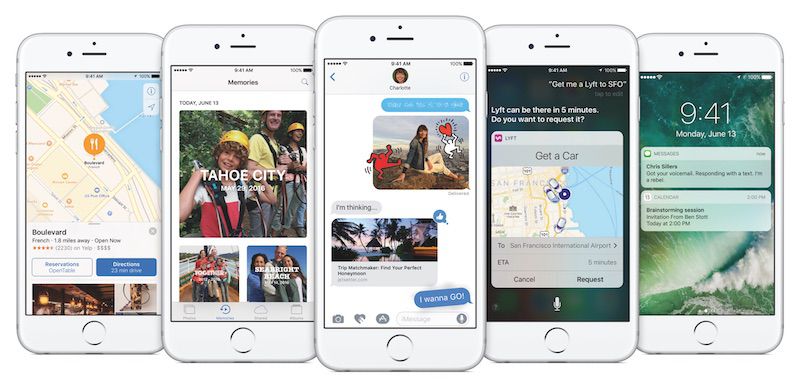
What's New in iOS 10
Contents
Apple unveiled iOS 10, the next-generation operating system for the iPhone, iPad, and iPod touch, on June 13, 2016, releasing it to the public exactly three months later on September 13. According to Apple CEO Tim Cook, iOS 10 is the "biggest release ever" for iOS users, with major updates for a wide variety of apps, services, and features, including Messages, Siri, Photos, Maps, Apple Music, News, Apple Pay, Control Center, and more.
iOS 10 features a redesigned Lock screen with 3D-touch enabled notifications that offer up more information, a more easily accessible camera, and a new widgets screen that houses widgets formerly located in the Today section of the Notification Center. There's a redesigned Control Center, also with support for 3D Touch, and a new Raise to Wake feature wakes up the screen without bypassing notifications.
Siri can do a lot more in iOS 10, thanks to a Siri SDK that allows developers to build Siri support into their apps. You can now ask Siri to do things like summon an Uber or send a message in WhatsApp.
Messages has been overhauled with new features like background animations, bubble effects, rich links, and Digital Touch, the sketching feature first introduced on the Apple Watch, allowing users to create drawings and annotate photos and videos. Handwritten notes, hidden "invisible ink" messages, quick "Tapback" replies, and bigger emoji are new in Messages, and there's even a predictive emoji feature that suggests words that can be replaced with emoji.
Messages has its own Messages App Store, so developers can create apps that can be used in iMessages. Apps add almost unlimited capabilities to Messages, from sending stickers and GIFs to making payments to making collaborative dinner orders.
A dedicated "Home" app is available for HomeKit devices, and it's now possible to delete almost all pre-installed apps that are unneeded. Photos features impressive facial and object recognition capabilities, which power a new Memories feature for rediscovering forgotten moments.
Both Maps and Apple Music have been redesigned with cleaner interfaces that are simpler to use, with Maps gaining proactive suggestions and integrated third-party apps and Apple Music gaining better content discovery and a new focus on lyrics. Apple News has also been overhauled with subscriptions, breaking news notifications, and better organization.
Apple's QuickType keyboard is smarter in iOS 10 with contextual predictions, and Apple Pay is available on the web. Game Center has been largely eliminated, and many other apps, like Notes, Clock, and Phone have been updated with new features.
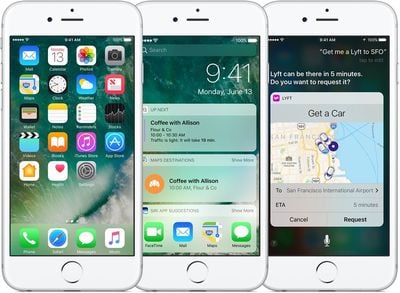
iOS 10 launched on Tuesday, September 13, 2016. It can be downloaded for free on the iPhone 5 and later, the iPad mini 2 and later, the iPad 4 and later, and the 6th generation iPod touch.
Current Version: iOS 10.3.2
The current version of iOS 10 is iOS 10.3.3, which was released to the public on July 19. iOS 10.3.3 is a minor update that focuses on unspecified bug fixes and security enhancements.
Apple is working on the next-generation version of iOS, iOS 11, and for that reason, iOS 10.3.3 may be the final update that is released for the iOS 10 operating system.
New Video App - Clips
Following the release of the iOS 10.3 update, Apple introduced a new video creation app called "Clips." Clips is designed to let users create expressive videos in a short amount of time, combining images, videos, music, filters, icon overlays, text, and more.
Videos created in the Clips app can be shared through Messages or on other social networks like Instagram and Facebook.
Lock Screen Overhaul
The Lock screen experience is all new in iOS 10, with a new Widgets side panel, a redesigned Control Center, revamped notifications, and the removal of the iconic "Slide to Unlock" feature. The Lock screen also has a bright, crisp new look, as incoming notifications no longer dim the wallpaper.
With the introduction of super fast Touch ID in the iPhone 6s and later, many users were bypassing their Lock screens and thus their notifications before being able to view them, so Apple implemented some changes to prevent that from happening.
A "Raise to Wake" feature activates the Lock screen of the and later when picked up, displaying all information on the screen without the need to put a finger on the Touch ID home button.
"Slide to Unlock," the feature that let you swipe right to access the passcode screen, has been eliminated, as has the accompanying text. The iOS Lock screen now instructs users to "Press home to unlock" on a device that has yet to be unlocked with a finger registered to Touch ID or "Press home to open" on a device that has been unlocked but not opened to the Home screen.

On pre-iOS 10 devices, Touch ID used to simultaneously unlock an activated device and open it to the Home screen when a finger was placed on the Touch ID button, but now a physical press is required as an extra step. That way, notifications can be read in full before a device is unlocked, preventing them from being missed.
Replacing the "Slide to Unlock" passcode screen is a new Widgets panel, activated with a swipe to the right. The Widgets panel displays all of the widgets that were previously available in the Today section of the Notification Center. iOS 10 brings a few new built-in widgets, including Mail, Maps (Destination, Nearby, and Transit), favorite contacts, Music, Notes, and Photos (Memories).
Widgets are not available in the Notification Center when on the Home screen, but when in an app and accessing the Notification Center, widgets continue to be available through a right swipe on the screen.
Swiping to the left on the Lock screen now brings up the camera, making it easier to quickly take a photo.
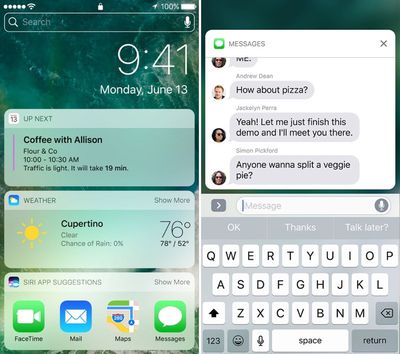
Incoming notifications have been enhanced with 3D Touch capabilities on the iPhone 6s and later, allowing users to do more without leaving the Lock screen, like viewing photos and videos and responding to incoming iMessages. Notifications are also streamlined across watchOS, tvOS, and iOS, and developers now have tools for updating old notifications with new information.
This is useful for something like sports scores, allowing users to see the most recent information without having to wade through old scores as in the screenshot below. Notifications can also be delivered based on push, calendar time, or location, and custom layouts and looks with rich media are available.

The Notification Center itself no longer has a "Today" view, offering up a simple list of all incoming Notifications and a search bar for quick access to Spotlight search. 3D Touching in the Notification Center now offers up an option to clear all notifications at once, a nice change for quicker notification management.

The last component of the Lock screen, Control Center, has been redesigned with a new look and new 3D Touch shortcuts for the Flashlight (change intensity), Timer (pre-set intervals), and Camera (picture options). Control Center also features multiple screens now, with a left swipe opening up a dedicated set of music controls and another swipe to the left bringing up controls for HomeKit devices.
Home Screen Tweaks
Unlike the Lock screen, the Home screen of the iPhone looks largely the same, but there are expanded 3D Touch capabilities. When you 3D Touch on an app that has an accompanying widget, it'll pop up right alongside other Quick Action options. There are a lot of new 3D Touch features in iOS 10, all of which can be seen in the video below.
You'll also see some new animations when opening and closing apps and folders, and when swiping to the right on the Home screen, what used to be the proactive search section is now a widgets panel identical to what's available on the Lock screen panel.
Siri Features
Siri SDK
Apple introduced a SiriKit SDK in iOS 10, which allows Siri to be integrated into third-party apps for the first time. With third-party app support, Siri is able to do more than ever before. Commands like "Get me an Uber to SFO" or "Send John $20 with Square Cash" or "Call mom with Skype" are all available. Siri's new functionality has been described as "long over-due" and a feature that makes the personal assistant much more useful in everyday life.

Siri integration is available for six different kinds of functions: ride booking, messaging, photo search, payments, VoIP calling, and workouts. That means Siri can book rides, send messages, search photo apps for specific images or videos, make and request payments, place calls in apps like Skype, and initiate workouts. In CarPlay, there's a specific function for accessing climate controls and adjusting radio settings.
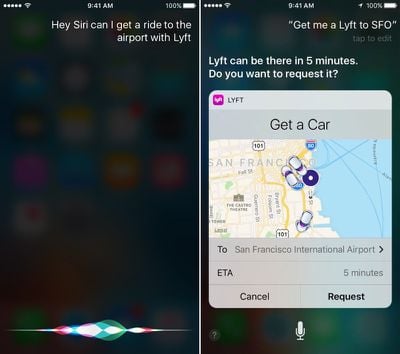
Functionality in SiriKit is limited to these types of apps to allow Apple to keep a tight rein on privacy, control the Siri experience, and develop Siri's understanding of language and context, but it in the future, Apple plans to expand it to encompass other types of apps. Third-party apps are only privy to the specific data necessary to perform a requested function, keeping user information locked down.
QuickType Keyboard
Siri intelligence has been expanded to the keyboard in iOS 10 with new contextual predictions to bring up suggestions in apps like Messages and Mail based on information like location and calendar availability or contacts.
Along with better predictions, QuickType also supports multiple languages without the need to switch keyboards, a feature that's handy for anyone who regularly sends messages in two or more different languages. It's able to automatically detect when a user changes languages.
Deleting Stock Apps
People have long wanted a way to delete the apps that come pre-installed on iOS devices to get rid of icons for apps that aren't in use, and in iOS 10, that's finally possible.
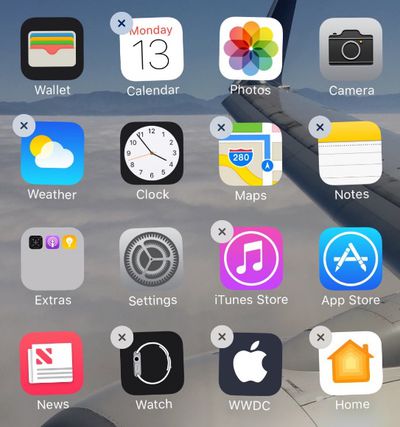
Many built-in iOS apps in iOS 10 have been moved to the iOS App Store as standalone downloads, allowing them to be deleted and re-downloaded at will. The following built-in apps can be removed on iPhone, iPad, and iPod touch devices in iOS 10:
Calendar
Compass
Contacts
FaceTime
Find My Friends
Home
iBooks
iCloud Drive
iTunes Store
Mail
Maps
Music
News
Notes
Podcasts
Reminders
Stocks
Tips
Videos
Voice Memos
Watch app
Weather
Apps that are "removed" from an iOS device aren't technically deleted because they are still part of the base operating system, so it's better to think of them as hidden. Removing the built-in apps deletes user preferences and necessary hooks, but the underlying binaries remain. For that reason, these apps are not updated through the App Store and re-downloading them simply restores the hidden functionality.
According to Apple, all the stock apps only take up 150MB of storage space, so there's not a lot of benefit to be had from deleting them entirely, and doing so would break key iOS features.
Messages
Because Messages is the most used app on the iPhone, Apple has given it a lot of attention in iOS 10, introducing new features to make iMessages more personal, emotive, and fun.
iMessages can be sent with an animated background, like balloons, confetti, and fireworks, or they can be emphasized with a "Bubble Effect," designed to slightly tweak the animation of a received message to convey emotions like "loud" and "gentle." There's also an "Invisible Ink" Bubble Effect for a surprise-like impact, with text that remains hidden until a finger is swiped across it, and you can add quick "Tapback" replies to messages in the form of a heart, a thumbs up, and more by double tapping on a chat bubble.

Digital Touch, the sketching feature first introduced in the Apple Watch, is now available in Messages. With Digital Touch, you can send drawings, heartbeats, and taps to friends, and on iOS devices, Digital Touch can incorporate photos and videos that you can draw on. Digital Touch messages play out as they were drawn when sent to a friend.
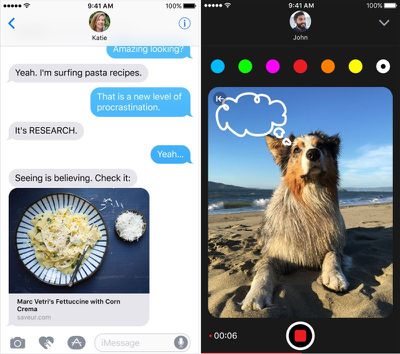
Messages now supports rich links, so you can see previews of content like websites right in the messages feed, and there's a built-in camera tool for snapping an image without leaving the app.
When sending a picture in Messages, tapping on it brings up editing tools and a Markup feature that can be used directly in the Messages app. The editing tools are the same as the tools available in the Photos app, allowing users to adjust image parameters like exposure, saturation, and brightness, and Markup can be used to annotate images with text and sketches.
Messages has a built-in handwriting feature for sending handwritten messages to friends. Tapping the new pen button at the bottom right of the keyboard brings up a touch pad where words can be written with a finger.

When receiving one to three emoji in an iMessage, the emoji are now displayed in a bigger size. More than four emoji or emoji sent with text continue to be the standard emoji size.
Along with bigger emoji, iOS 10 brings a fun new emoji prediction feature to the keyboard. When typing, you'll get emoji suggestions right alongside words, and if you type a sentence and then switch to the emoji keyboard, all words in your sentence that can be replaced with emoji are highlighted. Tapping them turns them to emoji.

Apple is also introducing a dedicated App Store for Messages, which houses apps with extensions that can be used in the Messages app. Simple apps that do things like allow you to send stickers and GIFs to friends are included, but the platform also supports more powerful apps that can do things like send payments or make a collaborative takeout dinner order with friends. All of this can be done without leaving the Messages app.

Stickers, which are available from the Messages App Store, have special properties. They can be resized, put on top of chat bubbles or other stickers, and be added to photos. Apple makes it easy to create stickers by dragging images into a designated folder in Xcode with no need to write code.

One minor but wished for feature has been added to Messages in iOS 10: Individual Read Receipts. You can now set read receipts on a per person basis, turning them on for some individuals and off for others.
Photos
The Photos app in iOS 10 has been updated with what Apple calls "Siri intelligence," which equates to new deep learning algorithms and advanced facial and object recognition techniques, aka computer vision.
Using these tools, Photos is able to scan a user's entire photo library, intelligently detecting people, animals, places, objects, and more. Based on this information, Photos groups images together to enable powerful search capabilities, allowing users to search through their images by topic. A search for "cats" for example, brings up images of cats, while a search for "beaches" brings up all beach images.

As for people, there's a dedicated "People" album that houses all of a user's images featuring people, which are grouped based on facial recognition. The end result is a highly organized Photos structure that makes it much easier to find content in large photo libraries.
According to code buried within macOS Sierra, the Photos app in iOS 10 and macOS Sierra is able to distinguish between seven different facial expressions including greedy, disgust, neutral, scream, smiling, surprise, and suspicious.
When it comes to scene and object recognition, it appears Photos is able to recognize upwards of 4,000 different items across a wide variety of categories.
One of the best new features in Photos is a "Memories" tab that uses image recognition, date, and location to aggregate photos based around certain days, vacation trips, family events, and more, so your photos can be revisited on a regular basis. With Memories, there are options to watch quick video montages of photos, which include theme music, titles, and cinematic transitions.

Some of the memory categories Photos surfaces includes Recent events, Last Week, Last Weekend, Year summary, Trips, Birthdays, and more.
Like Messages and Mail, Photos now incorporates a "Markup" editing tool for adding text and sketches to photos for annotation purposes, and there's now support for "Live Filters," which can be applied to Live Photos, along with Live Photos editing capabilities. Live Photos are also being updated with improved stabilization. For standard photos, there's an improved auto enhance function and a new brilliance adjustment slider.

The new features in Photos are powered by a device's GPU with all learning done on a device-by-device basis to ensure full privacy. Apple has made it clear that it does not see images or image metadata. When using the new Photos features, each device with a photo library needs to scan images independently -- there is no iCloud link.
New Apps, App Updates, and Other Features
Home
Apple added a standalone "Home" app in iOS 10, designed to control all of a user's HomeKit-connected products in one central spot. Home, available on the iPhone and iPad, offers quick access to favorite HomeKit scenes and accessories, plus a list of all rooms to make it simple to control several accessories at once.

With the Home app, either an Apple TV or an iPad can be set as a Home Hub to allow HomeKit accessories to be used when away from home. There's also a section to create automated routines to do things like turn the lights on at specific times.
Home is also built into the iOS Control Center, allowing users to access their smart home devices without needing to open an app.
In other HomeKit news, iOS 10 brings support for new types of devices, including video cameras, air conditioning units, and doorbells, and HomeKit products can be controlled through iOS 10's new interactive notifications.
Apple Music
Apple Music has been redesigned with a simpler interface that makes it easier to find new content to listen to. Tabs now include "Library," "For You," "Browse," and "Radio," for better content discovery, and a new "Search" tab makes searching for songs and albums quicker.

The new look of Apple Music focuses on album art, with a bright, simple aesthetic featuring bold headlines and lots of white space. Apple redesigned the app to bring "greater clarity and simplicity to every aspect of the experience."
Apple has removed the "Connect" tab that allowed for direct access to the built-in social networking service where fans can follow artists, but Connect posts from artists and follow suggestions can still be found in the "For You" section of Apple Music. For You now offers up a better mix of content, including daily curated playlists, and there are top charts for finding trending music.
When playing a song in Apple Music, there's a new built-in feature that displays lyrics, and it's easier to tell what music is located locally on your device through a new "Downloaded Music" section in the Library.
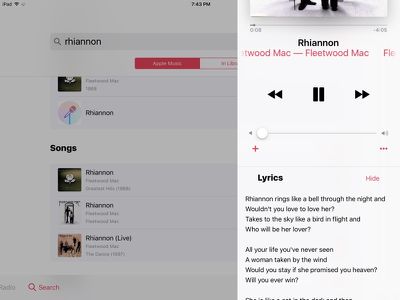
News
Apple News features a bolder, simpler interface to put content front and center. The main "For You" section has been broken up into smaller topic-based sections and improved organization to make it easier to keep up with incoming stories. "For You" features all of the topics a user follows, "Trending News," with current popular stories, and "Featured News" with suggestions hand-picked by Apple's editors.

Apple News now sends notifications whenever there's a must-read breaking news story, and it supports subscription-based publications so you can read content from The Wall Street Journal and other paid sites right alongside free content.
Mail has a new look with threaded conversations, which link multiple messages together in a single page. On the 12.9-inch iPad Pro, which has more screen real estate than other devices, Mail uses the same three-column view that's available on desktop machines.
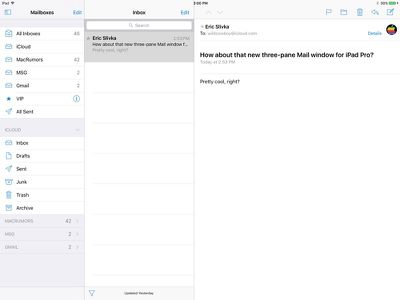
With threaded conversations, there are options in the Settings menu to display the oldest message or the newest message first, and for those who don't care for message threading, it can be turned off.
For incoming Newsletters, an automatic "Unsubscribe" button is shown at the top of each message to make it faster to unsubscribe to unwanted content, and a new smart move feature predicts which mailbox you might want to move a message to for users who have a lot of organizational folders in Mail.

There's a new filter button in Mail, and tapping on the funnel-shaped icon brings up a selection of filters that can be applied to a mailbox like unread, flagged, only mail with attachments, only from VIP, and more.
Maps
Maps has been redesigned with easier to access controls, destination suggestions that are front and center, and more prominent feedback tools. Maps now features traffic information en route and a dynamic view that pans in and out to allow users to look ahead to what traffic conditions are like.

iOS 10 includes Maps extensions for developers, so apps can integrate directly with the Maps app, letting users do more without having to open multiple apps. For example, with OpenTable integration, Maps can be used to book a dinner reservation, and with Uber integration, a user can call an Uber without leaving the Maps app.

Maps has also been updated with what Apple calls "Siri intelligence," and it is now able to make proactive suggestions based on where a user might want to go, offering up the fastest way to get there. Maps bases its suggestions off user habits, location, calendar events, and more.
If you often get directions to work at 8:00 a.m., Maps is able to bring it up as a suggestion and let you know if there's any traffic along the way. If you have a lunch date for noon and open Maps around that time, it'll offer up directions for your destination.
In iOS 10, there's finally a feature to search along a route that's been programmed into Maps, so you can find gas, food, coffee, and more on your trip. Maps adjusts routes to incorporate stops, letting you know how much time a detour might add.
When you park, Apple Maps automatically remembers your car location so you'll never forget where your car is, and Maps also now offers optional routes that avoid toll roads.

Many of the Maps changes are also available to CarPlay users.
Apple Pay
In iOS 10 and macOS Sierra, Apple Pay is available when making purchases via Safari. On participating websites, a "Pay with Apple Pay" button is available, and payments are authenticated via Touch ID just as they are within apps. Support for Apple Pay on the web started rolling out to websites shortly after the launch of iOS 10.
Differential Privacy
iOS 10 and macOS Sierra include a new Differential Privacy feature that allows Apple to gather data and customer usage patterns from a larg number of users without compromising individual security.
In iOS 10, Differential Privacy is used to collect data to improve QuickType and emoji suggestions, Spotlight deep link suggestions, and Lookup Hints in Notes.
Differential data collection is entirely opt in and users can decide whether or not to send data to Apple.
Single Sign-on
Introduced in December of 2016, Single Sign-on is a feature for iOS 10 and tvOS 10 that's designed to allow cable subscribers to sign in once with their cable credentials to gain access to all cable-restricted content in iOS and tvOS apps.
With Single Sign-on, customers with a supported cable provider can enter their credentials in "TV Providers" section of the Settings app. When using an app that supports the feature, cable subscribers won't need to sign in again to access content that requires a cable subscription.
Apps need to implement support for Single Sign-on, and at the current time, there are a limited number of apps that support the feature. A full list of apps that work with Single Sign-on can be found in Apple's Single-Sign on support document.
TV App
A "TV" app was introduced in iOS 10.2, replacing the Videos app. The TV app serves as a central hub for all TV and movies on iOS devices, bringing access to iTunes, purchased content, and a range of apps that offer both free and subscription TV and movies.
The TV app is kind of an Apple-designed television guide, highlighting content that users might want to watch. In addition to a store and library, it includes a "Watch Next" syncing feature that keeps track of what's being watched across multiple devices. It shows the next TV show in a series or the spot where a movie was paused.
Apple's TV app is currently only available in the United States. Other countries continue to have the standard Videos app.
iOS 10 Tidbits and Extra Features
Along with the major features in iOS 10, there are dozens of smaller tweaks features that have been implemented to refine the user interface and introduce new functionality. We've rounded up some of the best of the harder-to-find features in iOS 10 in the list and video below.
Split-View Safari on iPad - On iPads that support full Split-View multitasking, two Safari windows are now able to be opened side by side. Side-by-side Mail composing is also available on iPads.
Safari - Safari now supports an unlimited number of tabs.
Notes Collaboration - There are new collaborative features in Notes. Tapping on the new "Add People" icon in the app lets you invite other users to view and edit a note. All changes made by any user with access to the note sync to other users.

Copy and Paste - There's a new Continuity feature that allows copied content to sync across Mac and iOS devices. You can copy a link on an iPhone, for example, and paste it on a Mac running macOS Sierra.
iCloud Drive - When used in conjunction with macOS Sierra, the iCloud Drive app on iOS devices houses all Mac files located on either the desktop or the Documents folder for quick access anywhere.
Phone - Apple has created a new "CallKit" API that allows third-party VoIP apps like Skype to behave much like a standard phone call. There's also a new caller ID extension that can be used to screen phone calls for spam.

Voicemail transcription - In iOS 10, incoming voicemail messages are translated to text and can be read instead of listened to.
Bedtime Alarm - With bedtime alarm, it's possible to set a regular sleep schedule to get reminders to let you know when it's time to go to bed.

Music Storage Optimization - There are now options in the Settings app to optimize storage and remove songs that have not been listened to in a while. There are settings to limit music storage space to 8GB, 16GB, 32GB, and 64GB.
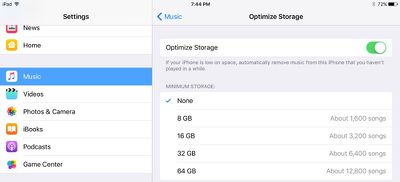
New Keyboard Sound - Keyboard sounds have been slightly tweaked. Backspace now has a distinctive sounds unique from other key press sounds, and there's a new sound for space, return, shift, and number/emoji shift. There's also a new general sound for all other key presses that's more of a muted popping-style sound.
Game Center - Apple has removed the Game Center app from iOS 10, but the Game Center service continues to be available.
TextEdit - A TextEdit app was spotted during the keynote event of the Worldwide Developers Conference, suggesting Apple may be planning to introduce a TextEdit app in a future beta.
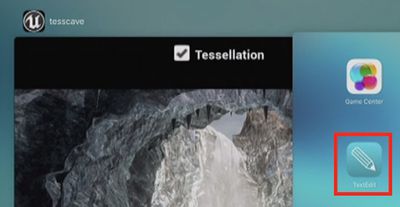
iOS 10 kernel - The first beta of iOS 10 features an unencrypted kernel, which is an intentional change that Apple implemented in the update.
VPN - PPTP connections for VPNs are being eliminated in iOS 10 and macOS Sierra. Apple recommends using other, more secure VPN protocols instead.
3D Touch App Downloads - When downloading app updates on an iPhone, a 3D Touch on an app icon allows a download to be paused. When downloading multiple items, it's also possible to choose to prioritize app downloads.

Organ donor registration - The Medical ID section of Health app now includes integration with Donate Life America to make it easy for users to register as organ donors in the United States. The functionality was introduced in the second beta version of iOS 10.

Safari - In iOS 10, Apple allows videos with no audio element to play automatically, which is useful for viewing video-format animated GIFs. Apple also plans to automatically pause videos that do have an audio element, cutting down on pesky spam videos.
Emoji - There are new emoji in iOS 10, designed to promote gender equality. Many professions and activity emoji that were previously limited to just one gender are now available with both male and female gender options. Emoji also have a new texture, many existing emoji have seen slight design tweaks, and Apple has replaced the "gun" emoji with a water gun.
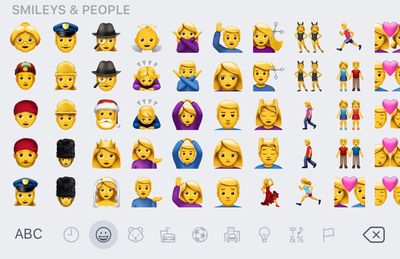
Lock sound - Apple introduced a new sound that plays when the power button on the iPhone is pressed to lock the phone. It sounds similar to a door closing.
iOS 10 How Tos
We've written a series of articles on how to use all of the new features in iOS 10, and they're useful to read through if you want to get more familiar with what iOS 10 is capable of. We've also got a few articles rounding up some of the best sticker packs and apps from the Messages App Store.
Compatible Devices
iOS 10 is compatible with the iPhone 5 and later, the fourth-generation iPad and later, the iPad mini 2 and later, and the 6th generation iPod touch.
Release Date
Following a beta testing period that spanned several months, iOS 10 was released to the public on Tuesday, September 13, three days ahead of the launch of the iPhone 7.
iOS 10 is available on the iPhone 5 and later, iPad mini 2 and later, iPad 4 and later, and the 6th generation iPod touch. It is a free download for all users with an eligible device.
Beyond iOS 10
In 2017, Apple plans to introduce its own social networking app, which will be similar to Facebook and Snapchat with a focus on sharing video. The app will reportedly allow users to record video, edit the video, add a filter, add doodles, and send it to freinds.
Apple is said to be aiming to make the app easy to use, with one-handed video controls and a streamlined process that will allow videos to be shot, edited, and uploaded in under a minute.
The app, currently designed to be a standalone app downloaded from the App Store, could potentially be introduced as an update to iOS 10 or it could come in iOS 11. There's also a possibility that release could be pushed back or scrapped altogether.

